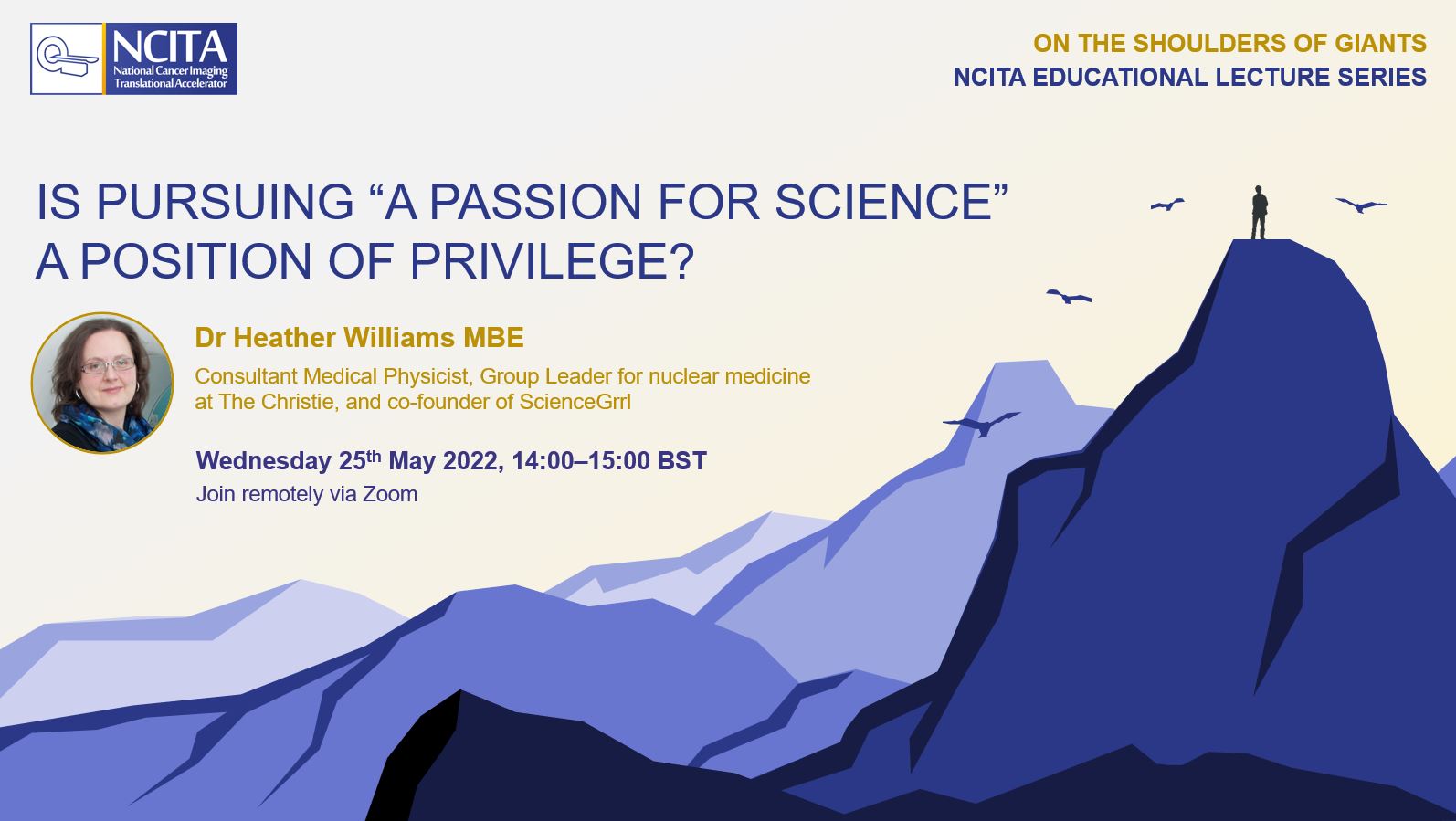On 25 May 2022, NCITA hosted the second lecture in the NCITA ‘On the Shoulders of Giants’ educational lecture series: “Is Pursuing ‘a Passion for Science’ a Position of Privilege?” with guest speaker Dr Heather Williams MBE, Consultant Medical Physicist, Group Leader for Nuclear Medicine at The Christie in Manchester, and Director of ScienceGrrl.
Whilst experiencing levels of bias throughout her career, Dr Williams reflected on how she has also had the opportunity to pursue her passions in research and STEM – opportunities that others may never have had the chance to experience. Dr Williams highlighted how these barriers can arise, the importance of acknowledging the disadvantages, biases and inequalities that exist in the world of science, and how we can work together to break down these barriers to ensure everyone can pursue their passion and talent for science.
Please visit the NCITA YouTube channel to watch the recording.
Choosing a road less travelled
Dr Williams’ journey to a career in medical physics is one that is certainly less well travelled – especially by women. In her career to become a consultant medical physicist, Dr Williams reflected on the multiple steps that helped her to get to where she is today – she was not the only girl in her school studying physics, and crucially her parents were open to the idea of pursuing her passion for physics.
“I do vividly remember my mum’s friends saying ‘why, aren’t you brave going and studying physics at university?” like I was this great pioneer into this unknown uncharted land, but for me it was completely normal because my parents were like ‘yeah, why not?’. And I think that really underpins why I felt comfortable making that choice.”
Why do fewer girls study physics?
Even though girls and boys perform equally as well at science GCSE level, half of all British coeducational state schools do not have a single girl studying physics A-level, and this imbalance that is introduced at A-level tends to persist all the way through university undergraduate and postgraduate physics qualifications.
The ScienceGrrl ‘Through Both Eyes’ report in 2014 collated research into factors affecting girls’ choices regarding STEM careers, exploring how the influences of home, school, workplace and wider society play a significant role.
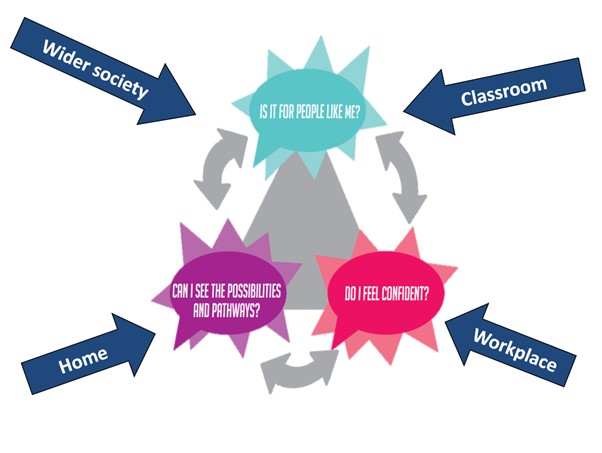
Dr Williams presented an overview of the ‘Through Both Eyes’ report – the diagram summarises factors affecting girls’ choices regarding STEM careers. Published 2014, free to download from www.sciencegrrl.co.uk
“The influence of home really cannot be underestimated. If your family doesn’t know anyone who’s a scientist, or only knows men that work in science and tech, then the inherent assumption is that science and tech are more likely to be something that is suitable for boys.”
The lack of girls pursuing a career in physics is still a topical issue. In April 2022, when asked why so few girls progressed to physics A-level, the UK Government Social Mobility Commission chair responded: “I just think they don’t like it. There’s a lot of hard maths in there that I think they would rather not do”.
Whilst this rhetoric is nothing new, the fact that this opinion is still presented as evidence to parliament, is consider by Dr Williams to be “both absurd and dangerous”.
Bias and underrepresentation in academia
This gender bias in physics continues into the world of academia. A publication from Moss-Racusin (2012) demonstrated how a group appointing a lab manager were presented with two identical CVs and qualifications – one from a man and one from a woman. The male applicant was scored higher on competence, ability and mentoring ability, and proposed a much higher starting salary and their qualifications.
“The paper from Moss-Racusin is the absolute one to have in your back pocket [when discussing the issue of gender bias in academia] when everyone goes ‘Yeah, but we as scientists are objective. We’re not subject to gender bias. We make decisions based purely on the data’!”
Across academia, we can also see a deficit between men and women, with women taking longer to reach assistant professor level in academia. Whilst these gaps are closing over time as support for working mothers in particular has improved, research by Viglioni (2020) into the impact of the COVID-19 pandemic has demonstrated an overall trend that women have published less during this time period – thought largely due to the wider societal pressures of caring for family and extended family.
For those interested in further reading on gender bias and potential solutions see Llorens et al. (2021).
Thinking to the wider picture, gender is by no means the only area in which we come across obstacles and challenges in science and academia. Whilst there is a distinct underrepresentation of women in STEM overall, there is also an underrepresentation of disabled people within STEM careers, plus an offset in terms of ethnic diversity within the STEM workforce. Other disparities are also less well documented, for example, the barriers faced by the LGBTQ+ community, of which there is a need for further research.
How can we work together to break down these barriers?
1. Understand your perspective
The coin model of privilege by Nixon (2019) helps explain how ‘systems of inequality interact with each other to produce complex patterns of privilege and oppression’:
“Whether you like it or not, you are born with a set of characteristics that will put you either in the privileged position or not privileged, even outright oppressed position compared to that system of inequality. So taking me, for example, yes, because of being a woman, I do sometimes face sexism and bias because of that, because but I’m white, and fairly middle class, I avoid a lot of the discrimination and bias.”
By understanding our own privilege relative to others, we should use this understanding to build those conversations and work together to dismantle this system of inequality.
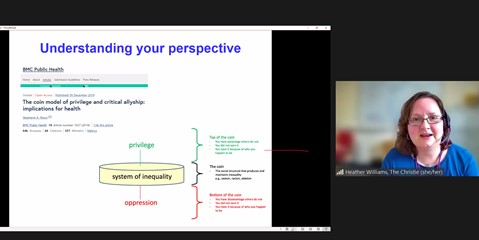
Dr Heather Williams presented an overview of ‘The coin model of privilege’ (Nixon, 2019)
2. Cite outside of your bubble
Morgan et al. (2018) found that ‘research from prestigious institutions is more readily published than work of similar quality originating from less prestigious institutions’.
“Champion the good work that comes from unexpected places.”
When referencing papers, a key recommendation is to focus on the quality of the research, rather than being influenced or biased by which institution or person this idea has come from.
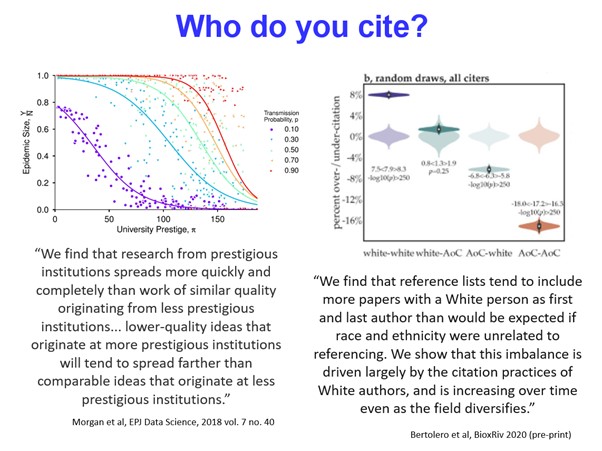
Dr Williams highlighted papers by Morgan et al. (2018) and Bertolero et al, (2020, pre-print) on how other publications are cited in academia
3. Take part in engagement and outreach activities
A helpful phrase, when designing any system for benefit particularly in patient-facing work, is “nothing about us, without us” – patients and the public should always have the opportunity to input into the systems that are ultimately designed for them. An example of this is a project ‘Our Health, Our Future’, led by Prof. Bella Starling, Wellcome Trust Engagement Fellow and Co-Director of Public Programmes at Manchester University Hospitals NHS Foundation Trust. The project brought together 12 to 17-year-olds from areas of Manchester with low health outcomes, to engage with health experts and inspire them to become agents of change within their communities.
Taking part in engagement and outreach is integral in demonstrating to a wide audience that science can be for everyone. Dr Williams reflects that a lot of the outreach activities she takes part in has a playful and creative edge, providing a powerful tool to an audience who initially may never consider science as a career, but also making it fun for both herself and others to take part in.
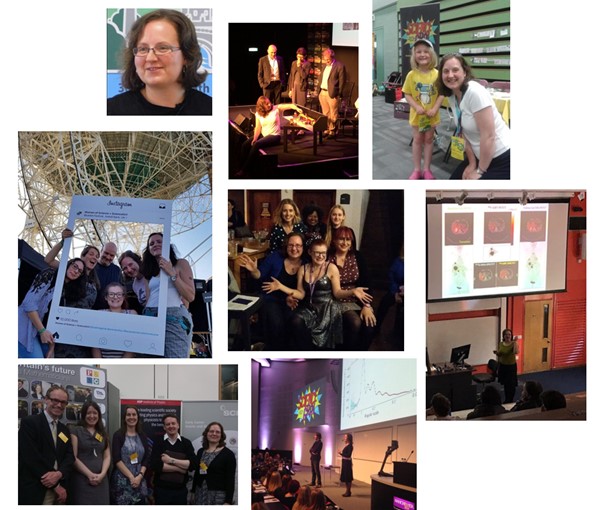
Photos showing the variety of outreach and engagement activities Dr Williams has taken part in over her career.
About the ‘On the Shoulders of Giants’ lecture series
‘On the Shoulders of Giants’ is a series of educational talks where experts bring their perspectives to encourage and challenge wider thinking within the cancer imaging research community. See below for other lectures in the series:
- April 2022: ‘Screening for Cancer: The Good, The Bad and The Ugly’ with Prof. Michael Baum. Link to blog & recording here.
- June 2022: ‘Academia & Industry: What are the Ingredients for Successful Collaborations?’ with Kieran Murphy and Prof. Evis Sala. Link to further information and registration here.
- July 2022: Guest speaker Prof. Tom Treasure. Save the date: 19th July. Further details TBC.


